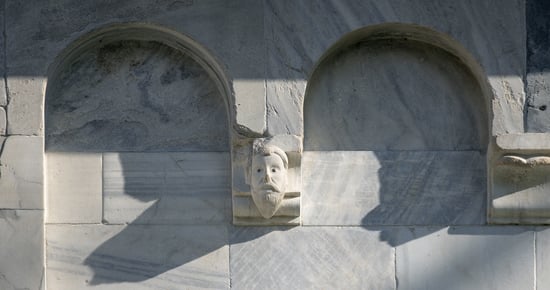Studenica Marble: Significance, Use, Conservation
Abstract
:1. Introduction
2. Historical Background of The Marble Stone Works and Use from Prehistoric Times to The Middle Ages
3. Research Process Phases
3.1. The Use of Studenica Marble on The Mediaeval Serbian Churches
3.2. Identification of the Mediaeval Quarries in The Vicinity of The Studenica Monastery
4. Studenica Marble Geology and Petrographic Description
4.1. Geological Fabric of Studenica Olistoplaque and Its Immediate Surroundings
4.2. Petrographic Description
4.3. Results of The Study Of the Studenica Marble at The Sites of Godovic and Vrh
5. Application of Studenica Marble in Restoring the Architectural Ornamentation Elements
5.1. Restoration of the Biforas on the Sopocani Monastery St Trinity Church
5.2. Restoration of the North Bifora on the Studenica Virgin’s Church West Façade
6. Discussion/Conclusion
Author Contributions
Funding
Acknowledgments
Conflicts of Interest
References
- Erdeljan, J. Studenica. An identity in marble. 3ozpa∮ 2011, 35, 93–100. Available online: http://www.doiserbia.nb.rs/img/doi/0350-1361/2011/0350-13611135093E.pdf (accessed on 16 July 2019). [CrossRef]
- Studenica Monastery, WHS. Available online: https://whc.unesco.org/en/list/389 (accessed on 16 April 2019).
- Malcer, B. Bibliography.Ed.V.Djuric. In The Studenica Monastery Treasure; SASA Gallery: Belgrade, SFR Yugoslavia, 1988; pp. 325–371. [Google Scholar]
- Čanak-Medić, M.; Bosković, D.J. Architecture of the Nemanja’s Period; RIPCM: Belgrade, SFR Yugoslavia, 1986; pp. 77–117. [Google Scholar]
- Nenadović, S. The Studenica Issues; Bulletin III. RIPCM: Belgrade, SFR Yugoslavia, 1957. [Google Scholar]
- Maksimović, J. Serbian Mediaeval Sculpture; Matica Srpska: Novi Sad, SFR Yugoslavia, 1971. [Google Scholar]
- Simić, V. Marble Stonecutting in Studenica and Cemerno. Ethnogr. Mus. Her. 1956, 19, 273–289. [Google Scholar]
- Simić, V. Ornamental and Structural Stone in the Studenica Wider Area. In The Herald; Geological Institute of Serbia Geological Institute of Serbia: Belgrade, SFR Yugoslavia, 1957; Volume XIV, pp. 245–278. [Google Scholar]
- Janjić, M. The PR of Serbia Geological and Engineering Features of the Terrain, Chapter: Carbonate Rocks; special editions; The Geological Institute of Serbia: Belgrade, SFR Yugoslavia, 1962; pp. 123–143. [Google Scholar]
- Dimitrijević, D.M. Geology of Yugoslavia, Chapter: Studenica Formations; GeoInstitute and Barex: Belgrade, FR Yugoslavia, 1995; Volume 79–81, p. 205. [Google Scholar]
- Bilbija, N. The Stone on the Studenica Virgin’s Church Façade Walls. The Stone Condition Research Results. The Studenica Virgin’s Church Marble Façades Restoration Project; RIPCM: Belgrade, Serbia and Montenegro, 2003; pp. 43–56. [Google Scholar]
- Hawkes, J.; Woolley, L. History of Mankind: Cultural and Scientific Development. Prehistory and the Beginnings of Civilization; Allen and Unwin: London, UK, 1963; Volume 1, pp. 63–103. [Google Scholar]
- Srejović, D. Dialogue between Stone and Man in The Stone and Man; The SASA Gallery: Belgrade, SFR Yugoslavia, 1990; pp. 92–119. [Google Scholar]
- Schmidt, K. Göbekli Tepe–the Stone Age Sanctuaries. New results of ongoing excavations with a special focus on sculptures and high reliefs. Doc. Praehist. 2010, 37, 239–256. [Google Scholar] [CrossRef]
- Göbekli Tepe, WHS. Available online: https://whc.unesco.org/en/list/1572/documents/ (accessed on 16 April 2018).
- Borić, D. Body metamorphosis and animality: Volatile bodies and boulder artworks from Lepenski Vir. Camb. Archaeol. J. 2005, 15, 35–69. [Google Scholar] [CrossRef]
- Bailey, D.W. Balkan Prehistory: Exclusion, Incorporation and Identity; Routledge: London, UK; New York, NY, USA, 2002; pp. 230–233. [Google Scholar]
- Renfrew, C. Before Civilization, Alfred A; Knopf: London, UK, 1973; pp. 120–122. [Google Scholar]
- Hood, S. The Arts in Prehistoric Greece; Penguin Books: London, UK, 1978; pp. 23–26. [Google Scholar]
- Gosden, C. Making sense: Archaeology and aesthetics. In World Archaeology; Godsen, C., Ed.; Routlege: London, UK, 2001; pp. 163–167. [Google Scholar]
- Srejović, D. Archaeological Lexicon: Prehistory of Europe, Africa and Middle East, the Greek, Etruscan and Roman Civilisations; Savremena Administracija: Belgrade, FR Yugoslavia, 1997; p. 237. [Google Scholar]
- Scarre, C. Monuments and miniatures: Representing humans in Neolithic Europe 5000–2000 BC. In Image and Imagination: A Global Prehistory of Figurative Representation; Renfrew, C., Morley, I., Eds.; McDonald Institute for Archaeological Research: Cambridge, UK, 2007; pp. 17–29. [Google Scholar]
- Fiora, L.; Alciati, L. Marmi e pietre antiche nel bacino mediterraneo=Ancient marbles and stones in the Mediterranean Basin. L’informatore del Marmista 2005, 44, 20–27. [Google Scholar]
- Longmen Grottoes, WHS. Available online: https://whc.unesco.org/en/list/1003 (accessed on 16 April 2018).
- Fischer, M. Marble from Pentelicon, Paros, Thasos and Proconnesus in ancient Israel: An attempt at a chronological distinction. In ASMOSIA VII, Proceedings of the 7th International Conference of Association for the Study of Marble and Other Stones in Antiquity, Thassos, the Aegean Sea, 15–20 September 2003; École française d’Athènes: Thassos, Greece, 2003. [Google Scholar]
- Camp, J.M. The Athenian Agora. Excavations in the Heart of Classical Athens; Thames and Hudson: London, UK, 1986; p. 38. [Google Scholar]
- Greenhalgh, M. Marble Past, Monumental Present: Building with Antiquities in the Mediaeval Mediterranean; Brill NV: Leiden, The Netherlands; Boston, MA, USA, 2009; Volume 80, pp. 20–26. [Google Scholar]
- Kergall, H.; Mine Sève, V. La France Romane et Gothique; La Martinière: Paris, France, 2001; p. 19. [Google Scholar]
- Macrides, R.; Magdalino, P. The architecture of ekphrasis: Construction and context of Paul the Silentiary’s poem on Hagia Sophia. Byz. Mod. Greek Stud. 1988, 12, 47–82. [Google Scholar] [CrossRef]
- Debljović Ristić, N. The Utilization of Traditional Technique of Architectural Stone-Carving in Serbian 12th and 13th Century Medieval Churches. Mod. Conserv. 2016, 4, 117–126. [Google Scholar]
- Millet, G. L’Ancien art Serbe. Les églises; Picard: Paris, France, 1919; p. 10. [Google Scholar]
- Djurić, S. Discovering the Studenica Ornamentation. In The Studenica Monastery Treasure; The SASA Gallery: Belgrade, SFR Yugoslavia, 1988; pp. 100–102. [Google Scholar]
- Nenadović, S. Construction Techniques in Mediaeval Serbia; Prosveta: Belgrade, Serbia and Montenegro, 2003; pp. 236–250. [Google Scholar]
- Kandić, O. Sopoćani. In History and Architecture of Monasteries; The SCS Herald: Belgrade, Republic of Serbia, 2016; pp. 66–74. [Google Scholar]
- Debljović Ristić, N. Mediaeval Religious Heritage—Principles and Procedures in Architectural Conservation. SCS Her. 2015, 39, 290–301. [Google Scholar]
- Brandi, C. Theory of Restoration; Publicum: Belgrade, Serbia, 2007. [Google Scholar]
- Primavori, P. Il Primavori: Lessico Del Settore Lapideo:[2500 termini]; Zusi, G., Ed.; Unlibrio: Verona, Italy, 2004; p. 415. [Google Scholar]
- St Simeon’s Hagiography; Collected Writings, translation: Mirković L., Bogdanović D.; Prosveta: Belgrade, SFR Yugoslavia, 1986; p. 97.
- Popović, M. The Monastery of Studenica Archaeological Discoveries; RIPCM: Belgrade, Republic of Serbia, 2015; p. 31. [Google Scholar]
- Janković, M. Archaeological Data on the Construction of the Virgin’s Church, Collection Dedicated to Boško Babić; Museum of Prilep: Prilep, SFR Yugoslavia, 1986; pp. 109–111. [Google Scholar]
- Pajković, V. Studenica Marble Basic Types with a View on Stone Slabs; Novopazarski zbornik; Museum”Ras: Novi Pazar, Republic of Serbia, 2010. [Google Scholar]
- Urosević, M.; Pavlović, Z.; Klisić, M.; Brković, T.; Malesević, M.; Trifunović, S. Basic Geological Map Vrnjci Sheet K34–18; The Federal Geological Institute: Belgrade, Serbia, 1964. [Google Scholar]
- Brković, T.; Malešević, M.; Urošević, M.; Trifunović, S.; Radovanović, Z.; Dimitrijević, M.; Dimitrijević, M.N. Guidebook of Basic Geological Map Ivanjica Sheet K34–17; The Federal Geological Institute: Belgrade, Serbia, 1977; p. 61. [Google Scholar]
- Aleksić, V.; Kalezić, M.K. Geology of Serbia, III-2. The Metamorphism of the Transitional Oceanic Lithospere—The Studenica Region; Aleksić, V.M., Petković, K., Eds.; Faculty of Mining and Geology, University of Belgrade: Belgrade, SFR Yugoslavia, 1977; pp. 99–209. [Google Scholar]
- Antula, D.J. Review of the Results in the Kondom of Serbia for the Paris Exhibition; State Printing Office of the Kingdom of Serbia: Belgrade, Kingdom of Serbia, 1900; p. 134. [Google Scholar]
- Operational Guidelines for the Implementation of the World Heritage Convention. Available online: https://whc.unesco.org/archive/opguide12-en.pdf (accessed on 19 May 2019).
- Kandić, O. Architectural Investigations and Conservation Works on the Sopocani Monastery; RIPCM: Belgrade, SFR Yugoslavia, 1984; pp. 7–29. [Google Scholar]
- Debljović Ristić, N. Restoration of the mullioned windows on the Holy Trinity Church of Sopocani. SCA Her. 2011, 35, 89–93. [Google Scholar]
- Debljović Ristić, N. Window restoration and conservation on the Holy Trinity Church of Sopocani. SCA Her. 2012, 36, 50–55. [Google Scholar]
- Tomić, S. An Unknown Document on the Studenica Monastery Restoration; The SASA Herald: Belgrade, SFR Yugoslavia, 1953; Volume V, book1; pp. 180–181. [Google Scholar]
- Debljović Ristić, N. Mullioned windows in the west façade of the church of the Virgine at Studenica. An analysis of the shapes and sculptural decoration. Bulletin 2017, 49, 26–42. [Google Scholar]
- Dragicević, L.J. Research of binders for rehabilitation the Studenica Virgin’s Church marble façades (1991). In The Studenica Virgin’s Church Marble Façades Restoration Project; RIPCM: Belgrade, Serbia and Montenegro, 2003; pp. 1–16. [Google Scholar]
- The Studenica Monastery Spatial Plan. Available online: https://www.mgsi.gov.rs/lat/projekti/prostorni-plan-podrucja-posebne-namene-manastira-studenica (accessed on 2 June 2018).
- Managing Cultural World Heritage Manual; United Nations Educational; UNESCO WHC: Paris, France, 2013; pp. 19–22.
- Feilden, B.M.; Jokilehto, J. Management Guidelines for World Heritage Sites; ICCROM: Rome, Italy, 1993; pp. 102–103. [Google Scholar]
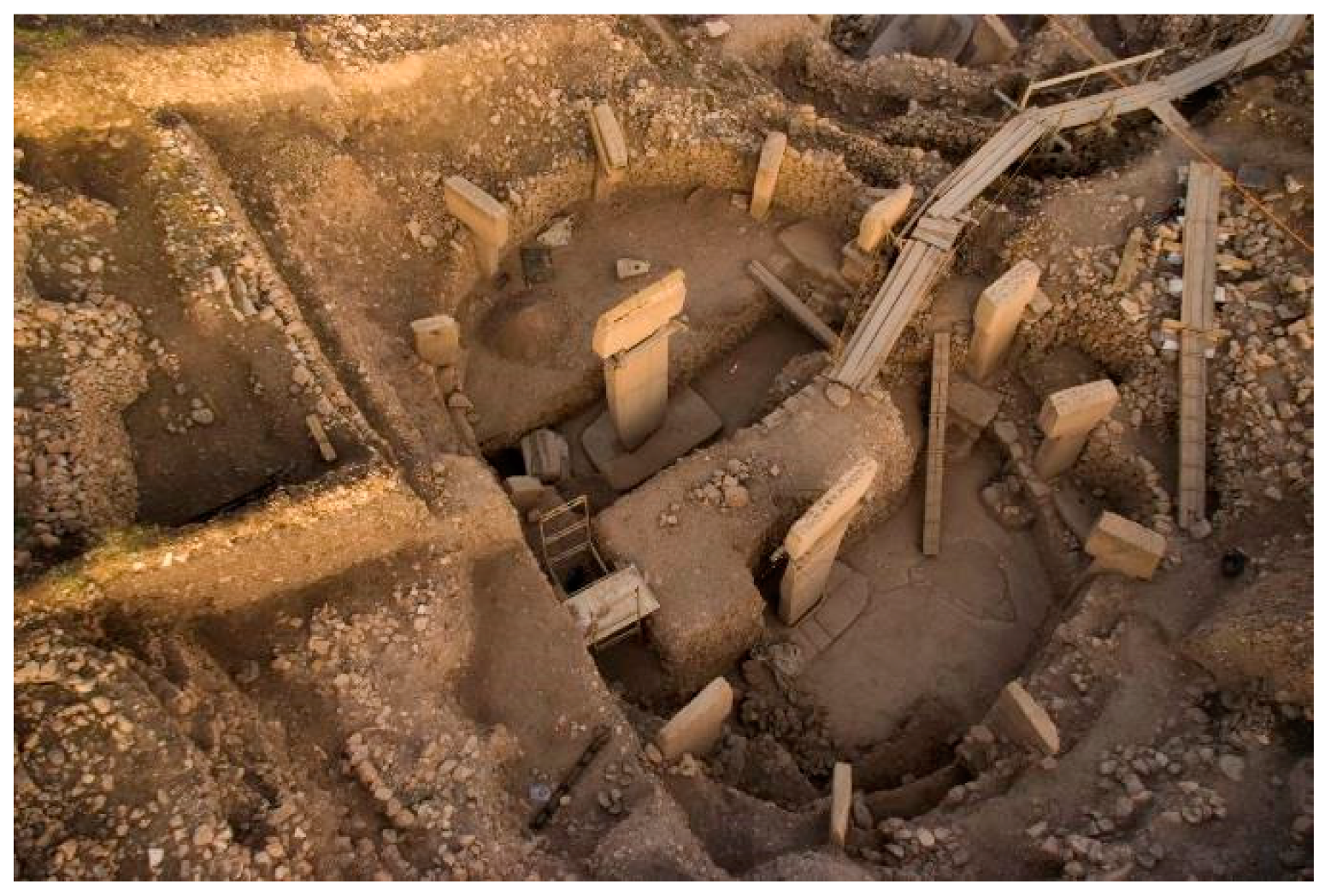
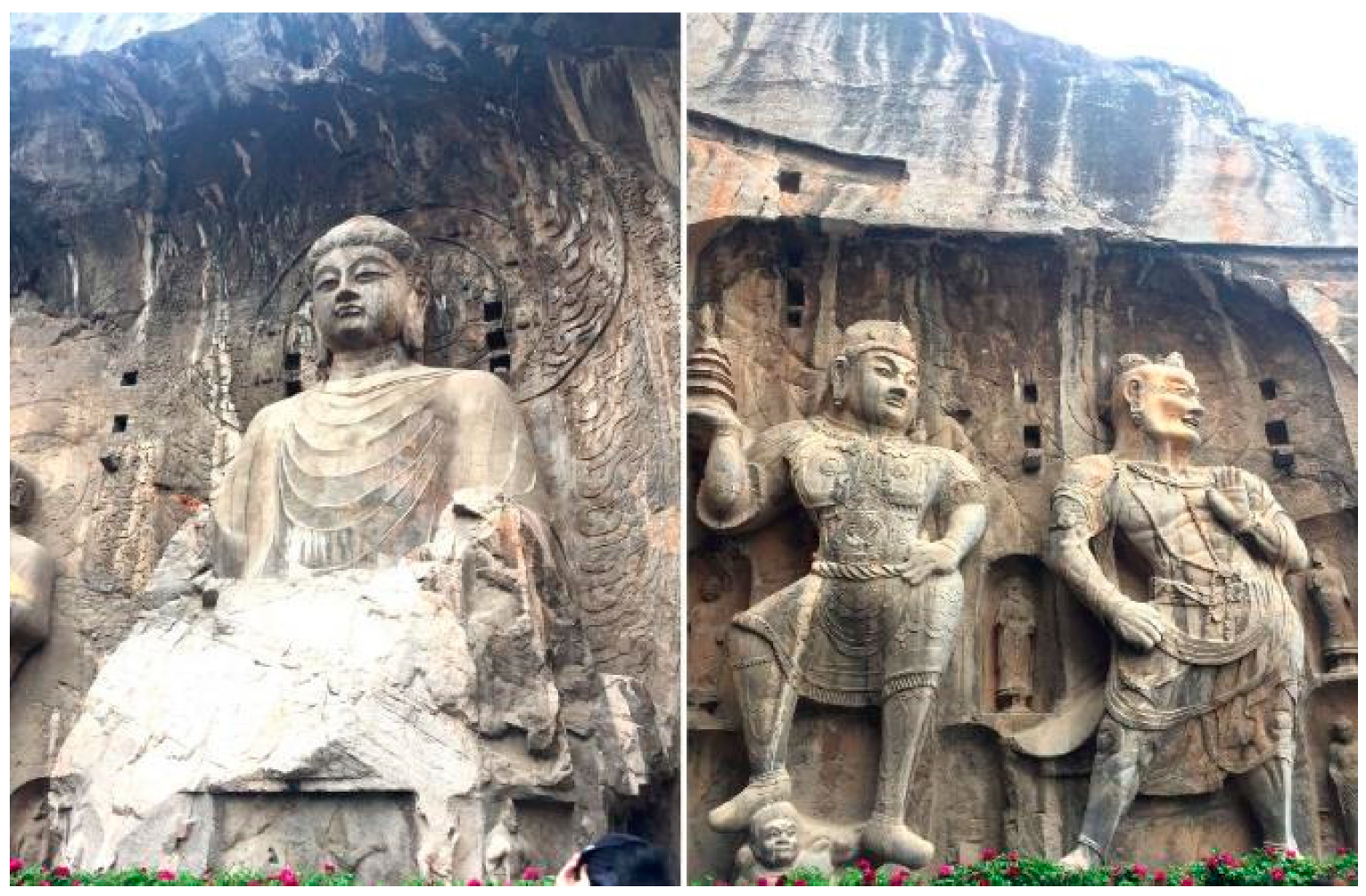
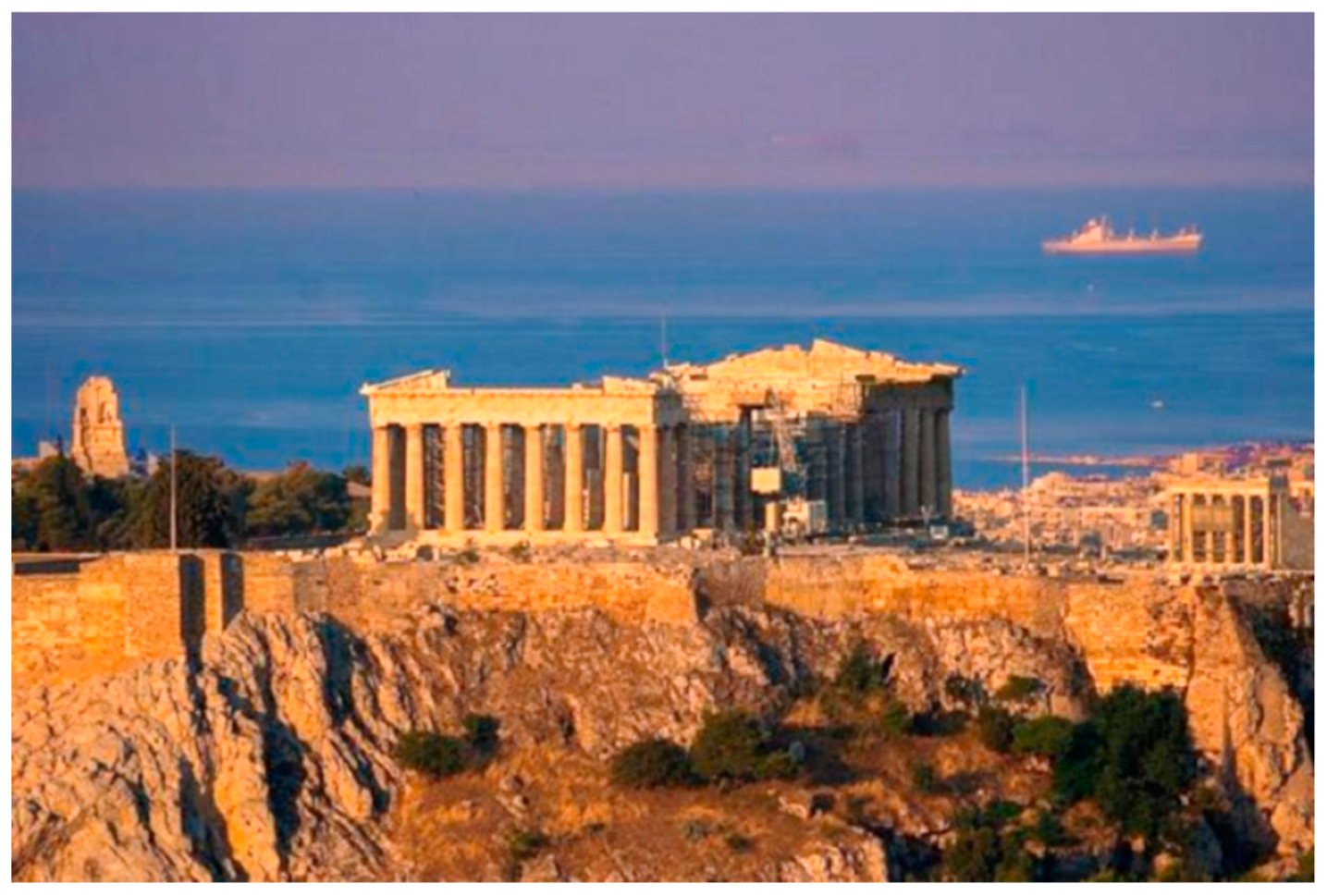
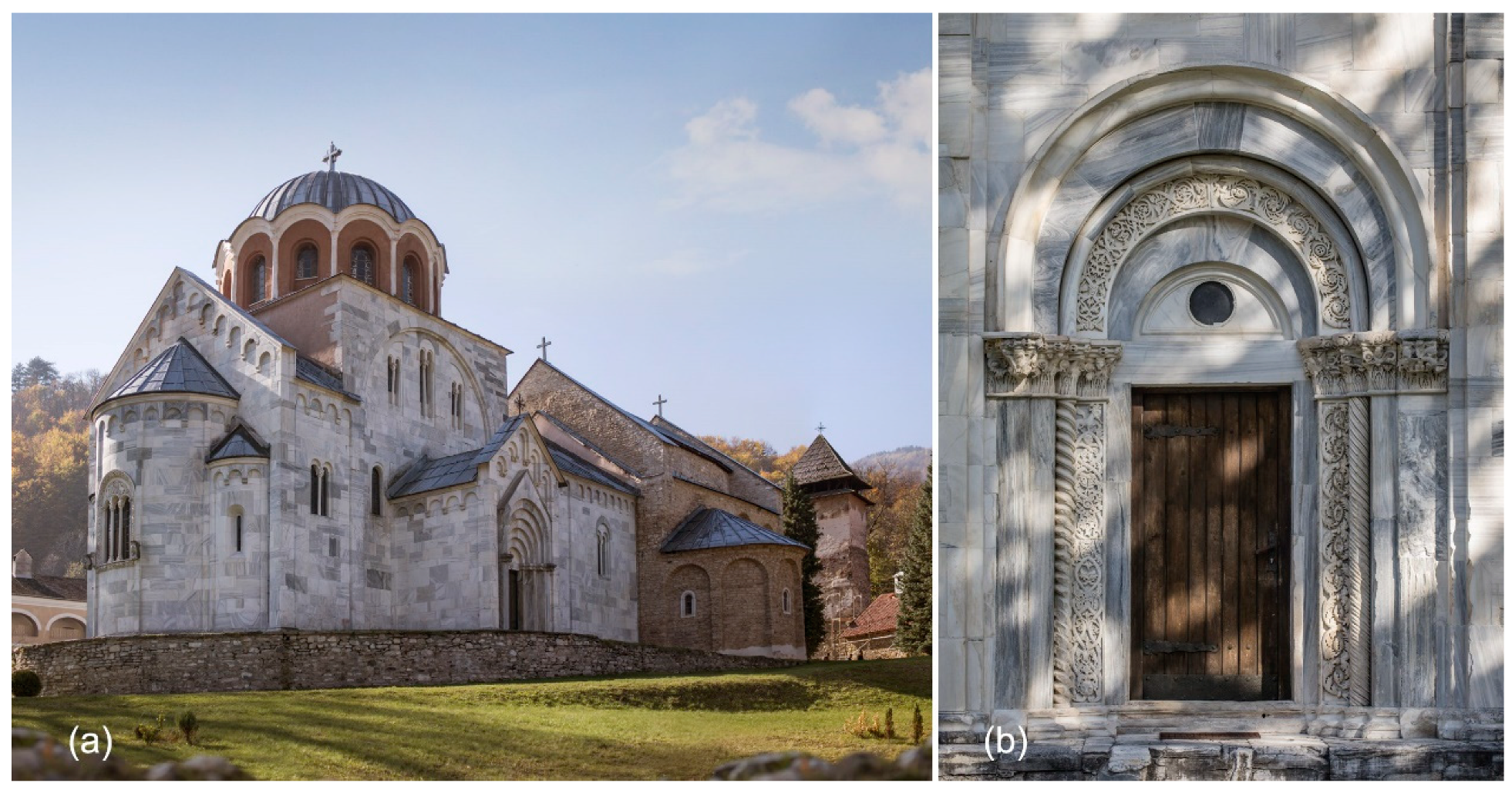

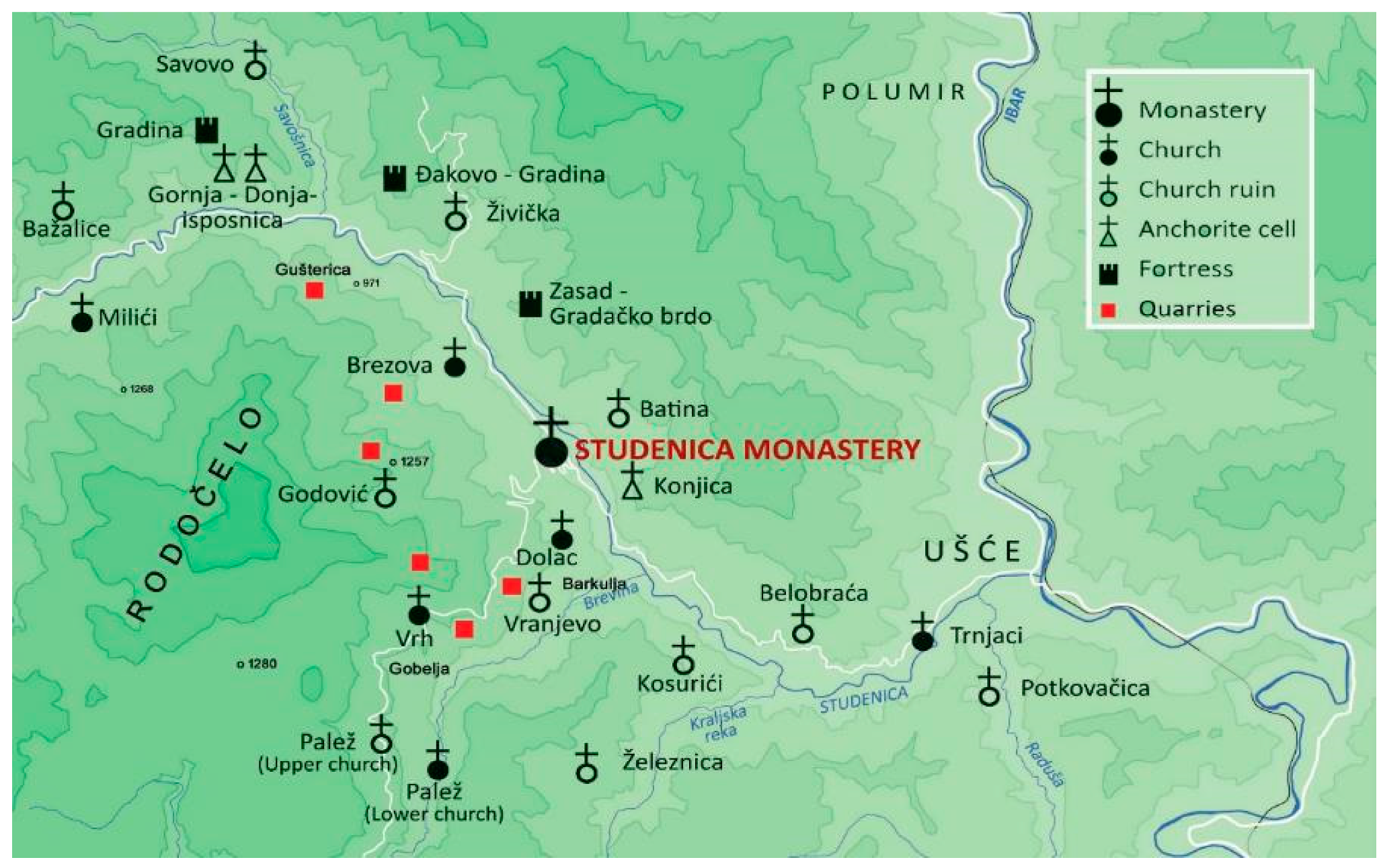

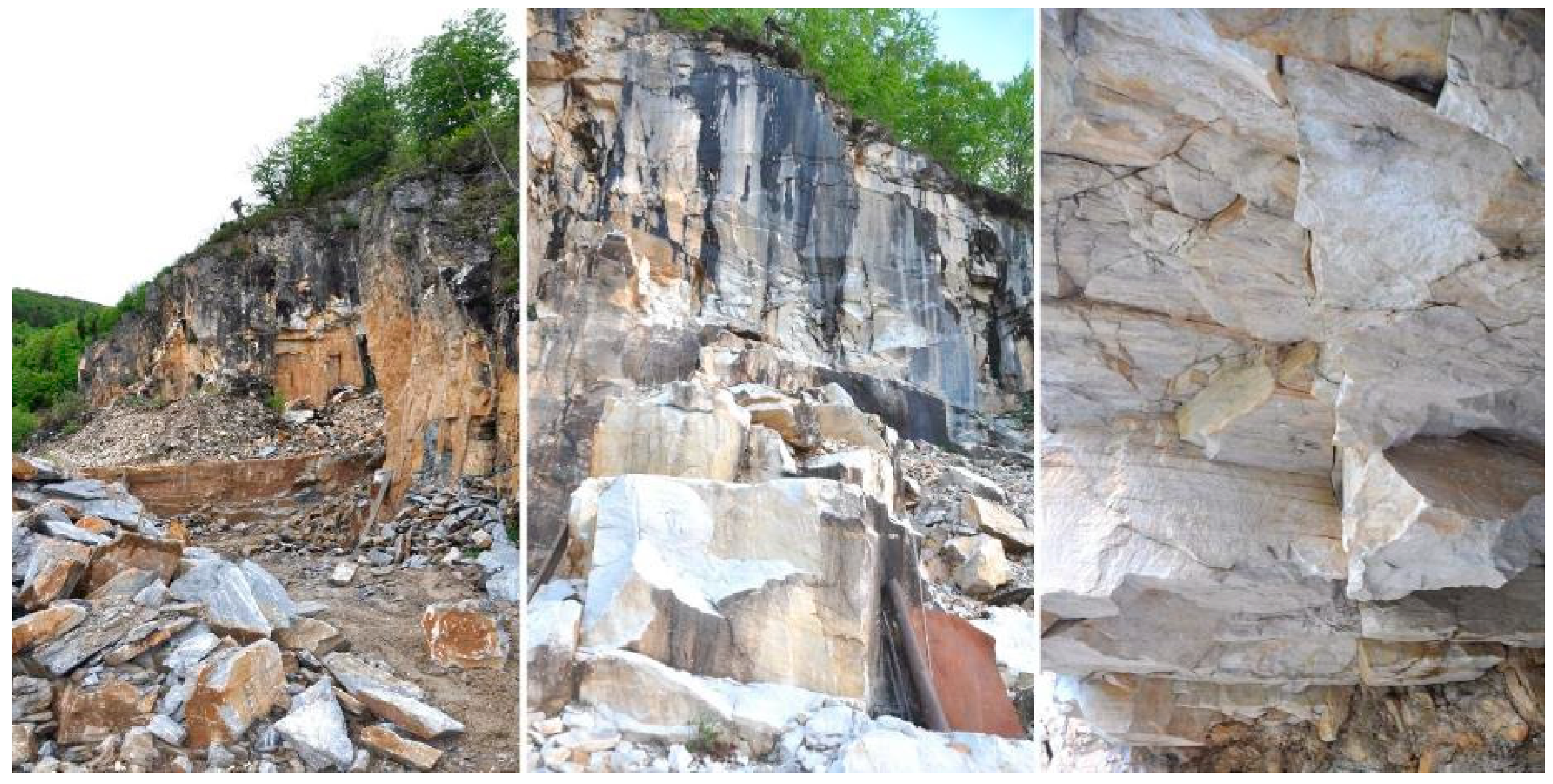
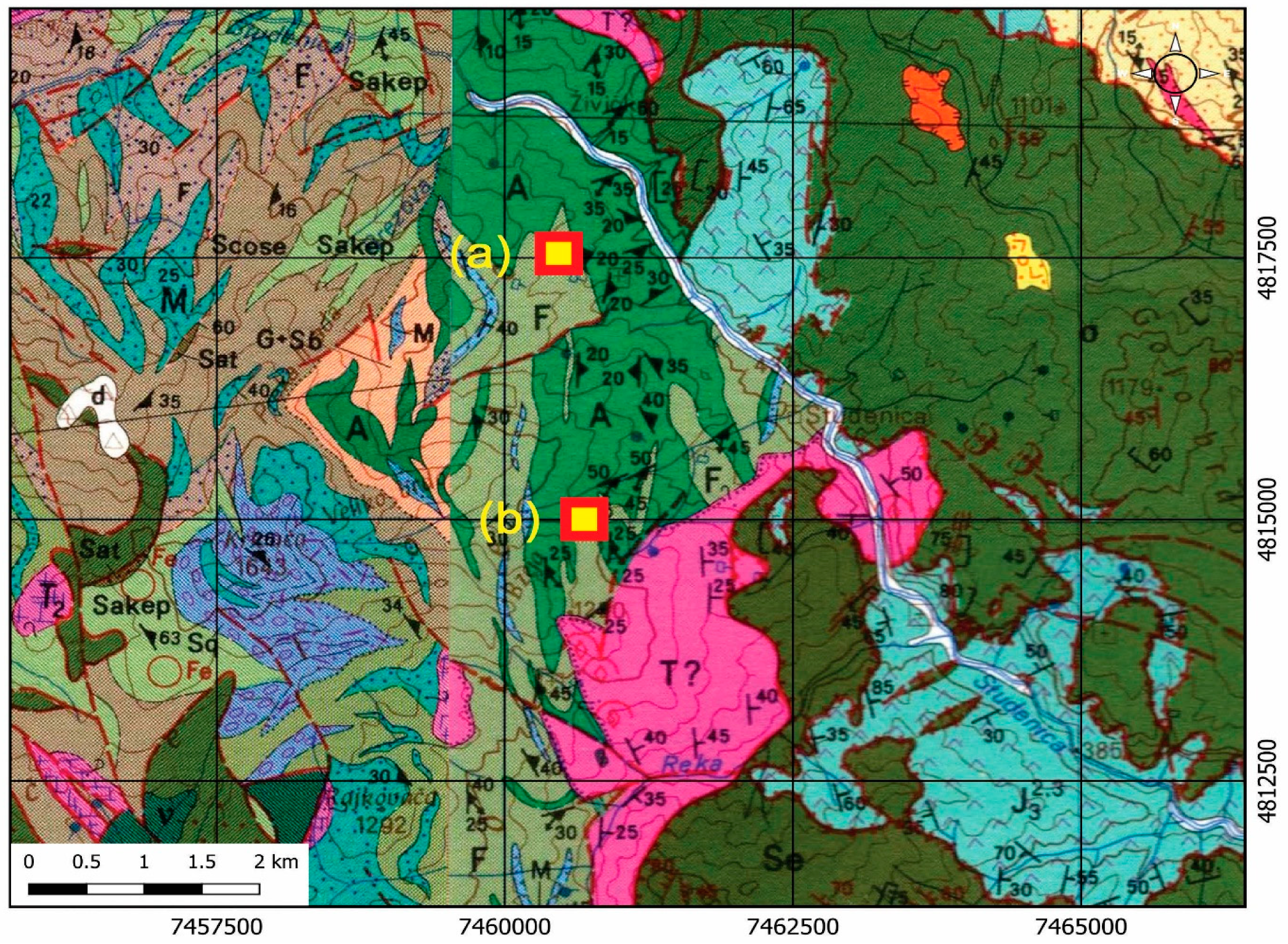
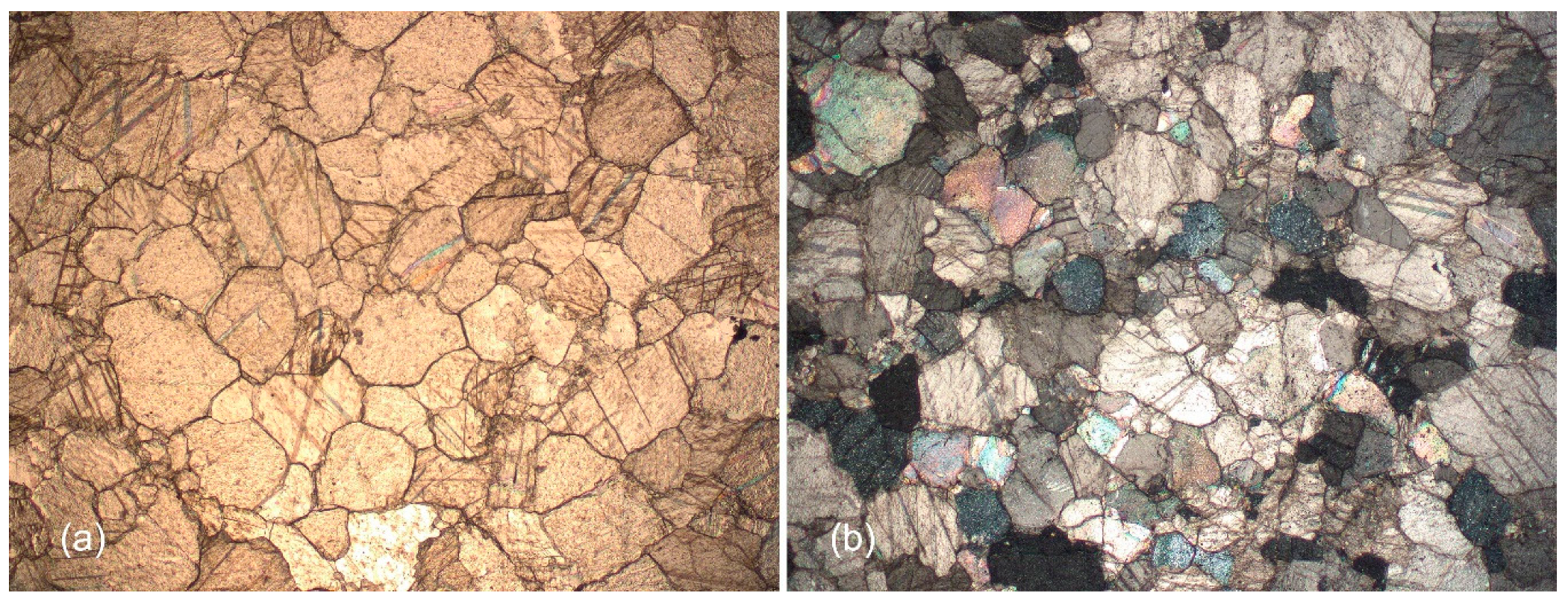
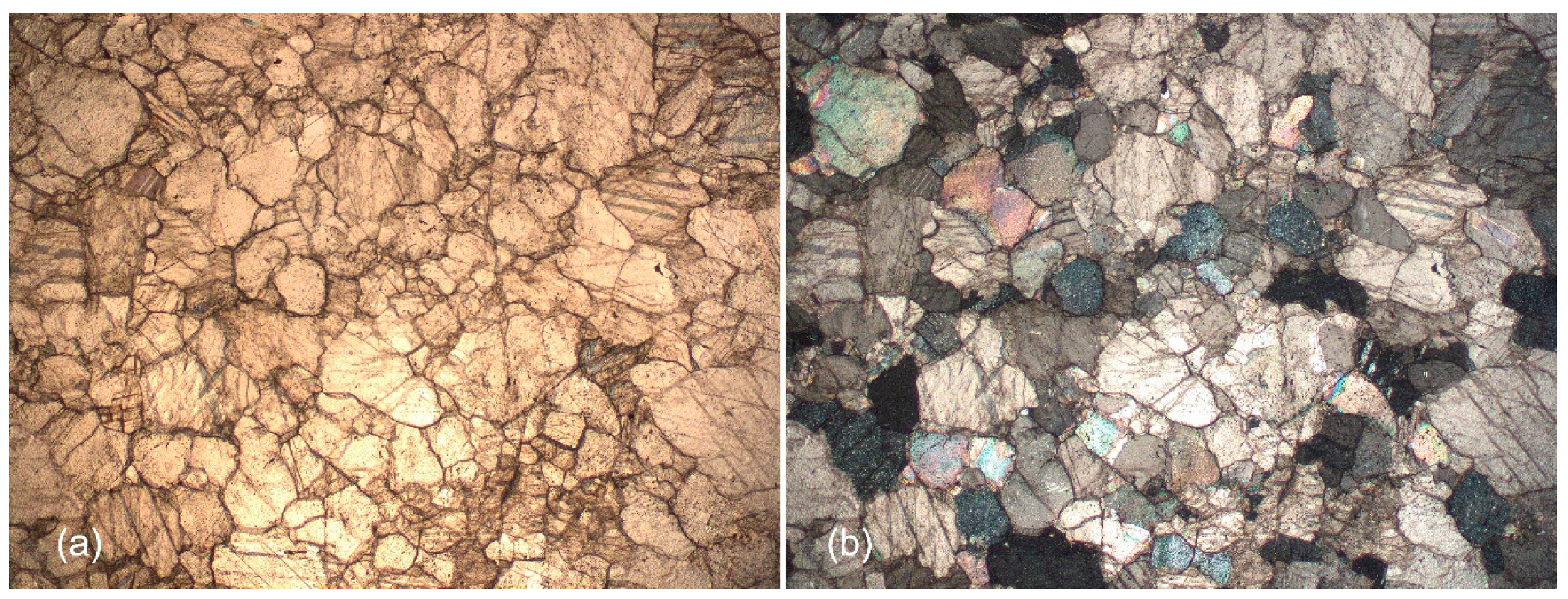

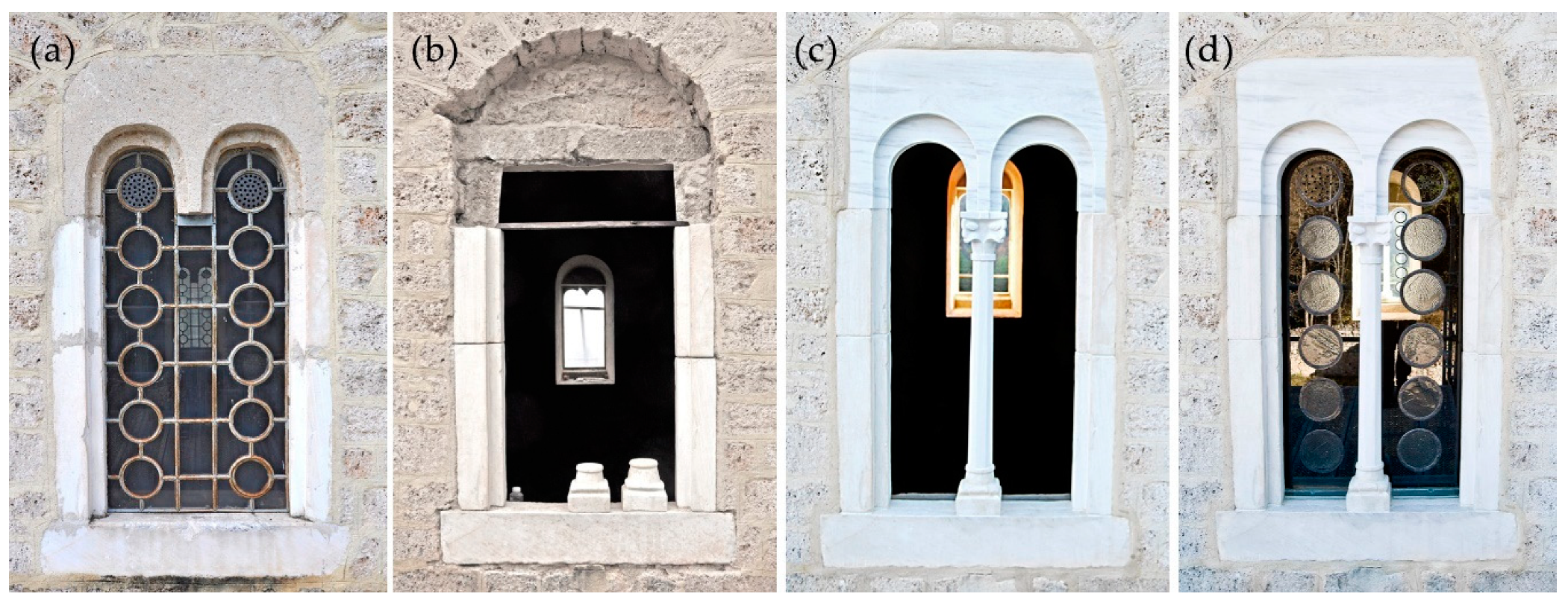
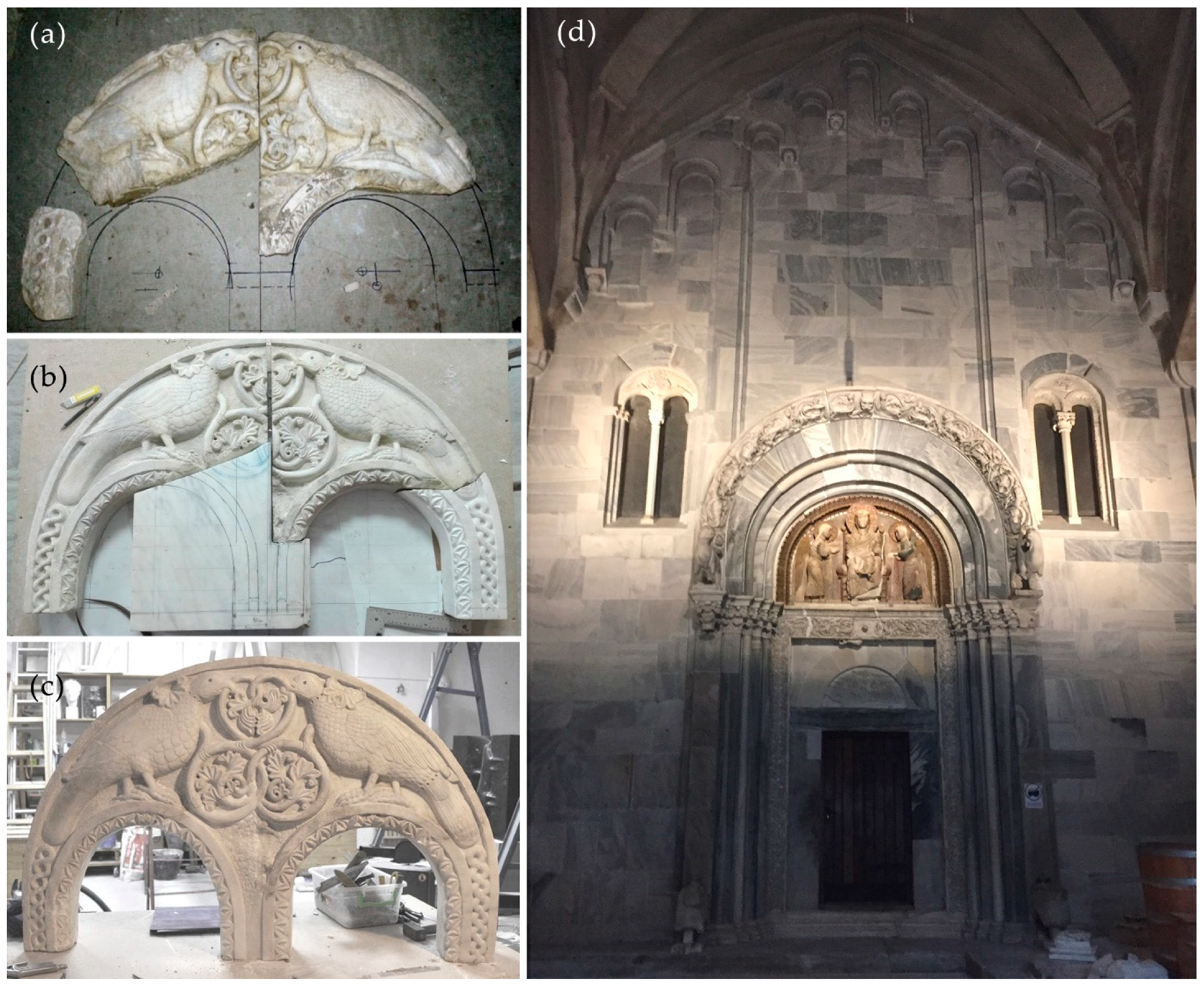
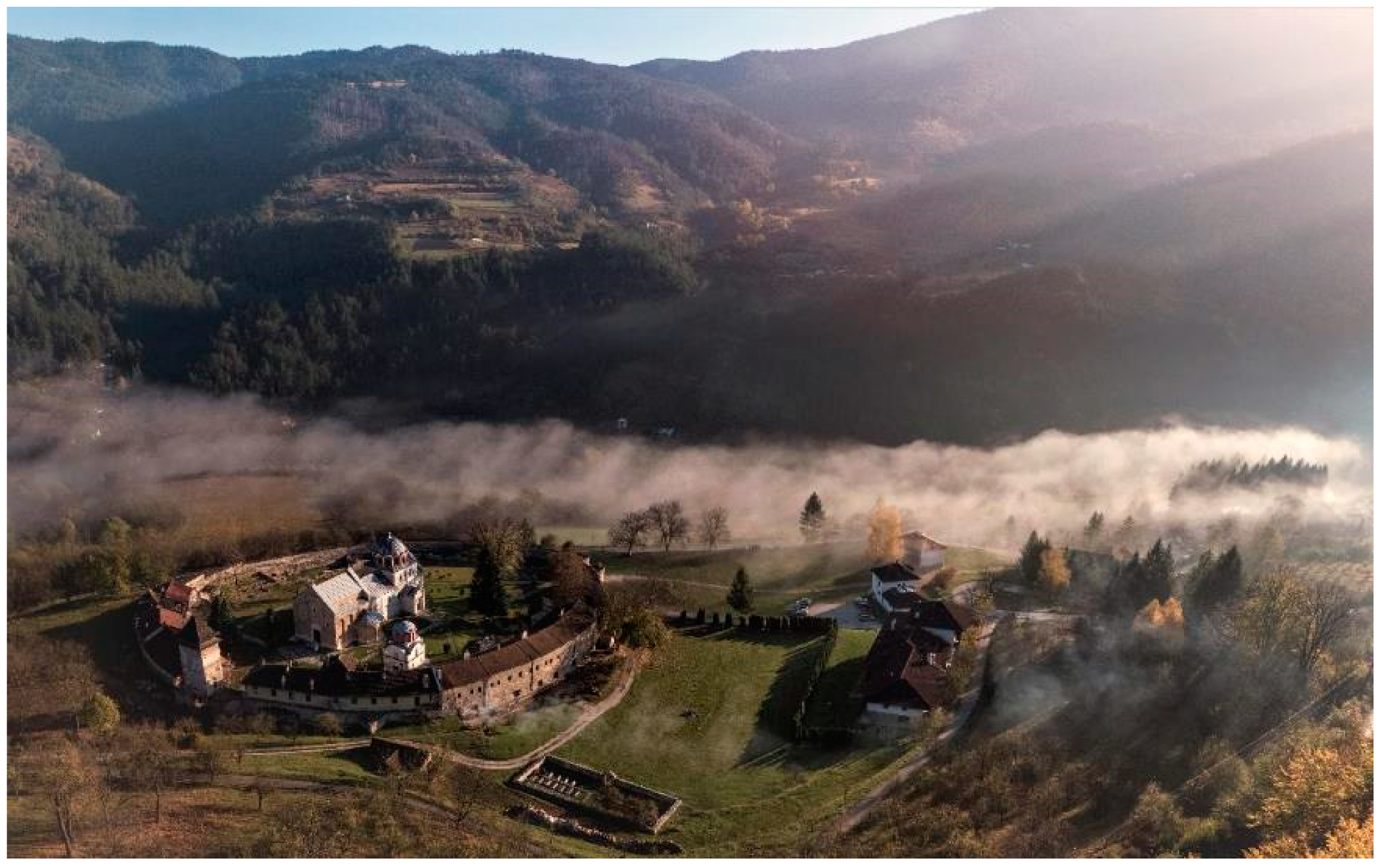
| Chemical Composition | SiO2 | Al2O3 | FeO | Fe2O3 | MgO | CaO | Other |
|---|---|---|---|---|---|---|---|
| Presence | 0.82% | 1.13% | 0.20% | 0.17% | 0.87% | 55.55% | 41.26% |
| Sample 1 | Sample 2 | Sample 3 | Sample 4 | Sample 5 | |
|---|---|---|---|---|---|
| Bulk density (g/cm3) | 2.68 | 2.69 | 2.67 | 2.67 | 2.64 |
| Water absorption (% of mass) | 0.16 | 0.11 | 0.18 | 0.30 | 0.36 |
| Open porosity (%) | 0.44 | 0.30 | 0.49 | 0.80 | 0.97 |
© 2019 by the authors. Licensee MDPI, Basel, Switzerland. This article is an open access article distributed under the terms and conditions of the Creative Commons Attribution (CC BY) license (http://creativecommons.org/licenses/by/4.0/).
Share and Cite
Debljović Ristić, N.; Šekularac, N.; Mijović, D.; Ivanović Šekularac, J. Studenica Marble: Significance, Use, Conservation. Sustainability 2019, 11, 3916. https://doi.org/10.3390/su11143916
Debljović Ristić N, Šekularac N, Mijović D, Ivanović Šekularac J. Studenica Marble: Significance, Use, Conservation. Sustainability. 2019; 11(14):3916. https://doi.org/10.3390/su11143916
Chicago/Turabian StyleDebljović Ristić, Nevena, Nenad Šekularac, Dušan Mijović, and Jelena Ivanović Šekularac. 2019. "Studenica Marble: Significance, Use, Conservation" Sustainability 11, no. 14: 3916. https://doi.org/10.3390/su11143916
APA StyleDebljović Ristić, N., Šekularac, N., Mijović, D., & Ivanović Šekularac, J. (2019). Studenica Marble: Significance, Use, Conservation. Sustainability, 11(14), 3916. https://doi.org/10.3390/su11143916




